ARCHITECTURAL PROJECTS
RESIDENTIAL
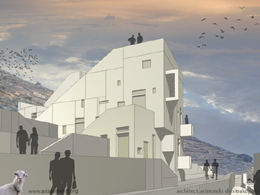
14 October, 2010
VI: Unrecycling Cyclades. Part 2
The residential prototype confronts, challenges and contrasts the ultimate stereotype of vacation home design in Hellenic seafront locations.
Specificity>Adaptability: The sectional scheme permits variable interior configurations, mainly because of the elimination of exclusively dedicated circulation space [corridors and stacked staircase shafts]. The highly customized formal scheme of the tectonic elements and the absolute absence of symmetries and repetitiveness may appear as contradicting any sense of flexibility and programmatic malleability. This is not the case though: demonstrating the potential of the project, a number of possible programmatic layouts is shown in sectional diagrams. The obvious limitation in re-assigning uses is the position of the hygiene spaces. The main volume may even conform to the extreme scenario of splitting into two fully independent units, each featuring a two-story one-bedroom layout. The tower suite can operate as an autonomous studio space, or alternatively, may act as an extension of the upper unit.
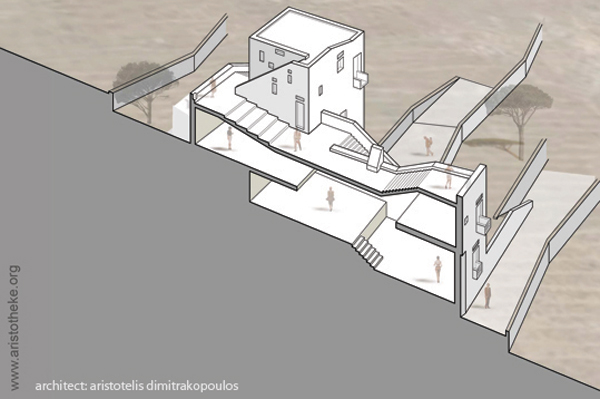
Hygiene: The main volume offers a full bathroom for common use, pulled closer to the upper bedroom. The front suite features two independent hygiene spaces, separating the bathing / showering area from the toilette, set remotely from the public areas of the house. This scheme optimizes the efficiency, allowing simultaneous use with no interference.
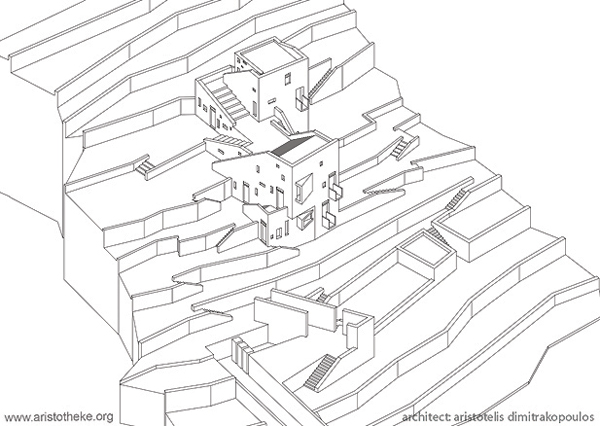
Front Suite Quarters [Access]: The mezzanine at the front of the main oblong volume is dedicated to private use, as the main bedroom. This elevated room takes advantage of sweeping panoramic views, rising high above the natural topography. This is a fully independent suite that may function separately from the rest of the house. The bedroom features two independent direct access routes linking to the outdoor, reinforcing the constant flux and flow between enclosed and open spaces. This central priority reflects the "experiential living" concept exploring the Cycladic terrain. Open doors and multiple circulation options optimize the exposure to the natural elements, offering variable control options for potential climatic shifts or even extremities [winds (meltemia), or excessive heat, glare, light and sun]. From the pool area this private domain is accessed through the outdoor stairs flanking the building volume, flowing rhythmically with the topography. From the opposite side, the bedroom can be entered through the veranda that progressively steps down to connect with the court. This scheme leaves the front elevation - the soaring edge of the house - undisturbed.
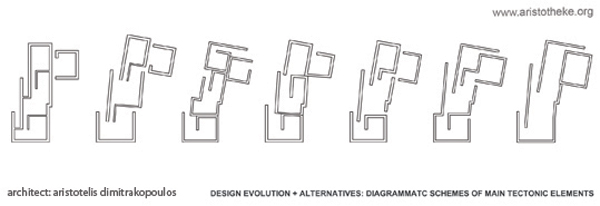
Front Suite Quarters [Outdoor]: A small timber-frame balcony develops at the front elevation offering deep views. The small dimensions of this balcony and the differentiated morphology allow this main vertical surface to read clearly, not competing with it. The small filigree timber cantilever makes the experience of the views even more breathtaking. The visual language of stone masonry and the idiom of vernacular architecture imply the use of multiple smaller openings on the wall surfaces [this directive is finally reinforced by building code that demands vernacular expression in new architectural works in the island]. The veranda on the side elevation provides a suitable wind barrier with its solid-wall railing, offering a more relaxed outdoor sitting space in direct link to the bedroom. This veranda on the north exposure is shaded in the mornings when the wind is milder, becoming an ideal "morning coffee" space, linked to the kitchen area through the outdoor ramp-stair.
Terracing: The roofscape becomes a public realm equipped for outdoor activities. The stepping configuration of variable density establishes a theatrical setting relating to the magnificent panoramas. The sectional differentiation in the roof elevation reflects the spatial organization beneath and responds practically to the prevailing north winds of the summer period, screening and protecting portions of the terrace. The creation of an urban space on a terrace [over a constructed roofscape] is common in the Cycladic islands in response to the steep and random topography.
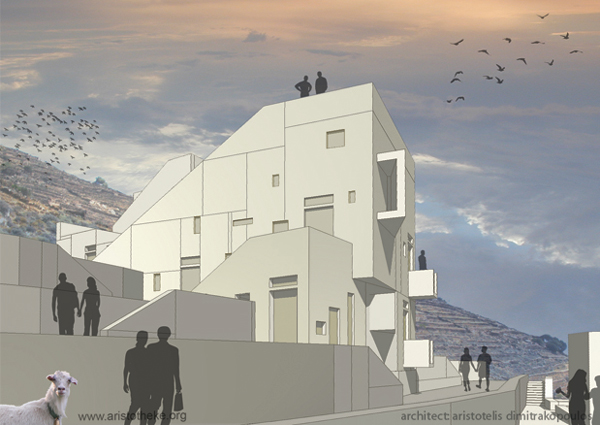
Punctured Solidity: The wall pattern Sdemonstrates a seemingly randomized pattern of openings and niches: narrow or larger, operable or fixed [glass block] openings blend with rectangular recesses and alcoves of variable depth. Certain windows are extruded, projecting and turning as to frame distinct views more evidently. As moments of sudden revelation [experiential surprise features], the framed vistas express sensitivity and modesty, evoking the serenity of the context. Addressing morphological economy and economy of means, the pattern of openings can be elaborated to conform to a prescribed spectrum of frame sizes.
Gastronomic Realm: The direct connection of the food preparation zone to the carport establishes a convenient loading gate and service entry. The north entry door, in close adjacency to the cooking area serves the possibility of dining in the north court, or taking breakfast or coffee to the bedroom veranda, to the roof, or to the master suite. The south entry door leads to the pool area and is regarded as the main access point to the interior of the house. The next outdoor deck, up the stairs, includes the outdoor grill and barbeque area where a dinner table can be set, protected from the prevailing winds and exposed to the views mediated by the piscine.
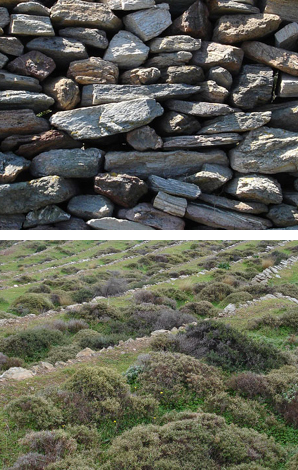
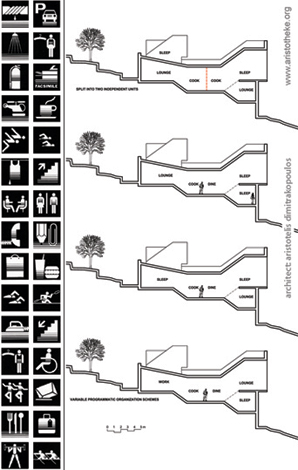
Indoor Banquet: The dining area, central to the overall interior layout, becomes a focal point of everyday life. The close proximity to outdoor and indoor programmatic entities, the ample height and the multiple apertures perforating the solid walls, the sense of containment and enclosure, the large central fireplace and the built-in alcoves and nooks, define a cozy sheltered area, the introverted kernel of the house. Three half-story stairs branch out connecting to the bedrooms and to the lounge deck. The stairs and the recessed decks establish a continuous engagement and interactivity between the various entities of the house. The dining table is strategically positioned to be used informally throughout the day.
Post-Dove Tower: The world-renowned dovecotes of the island of Tinos, a tradition inherited from the Venetian feudalism, are man-made pigeon-farms featuring mostly vertical morphological elements, essentially symbols of a social status and wealth. The dovecotes are morphed as small upright towers or larger prismatic shapes with multiple chapel-like forms projecting upwards. By introducing a vertical mass into Architheke VI an automatic association to the forms of the vernacular pigeon-houses arises. Traditionally the bird nooks are organized as intricate geometric patterns created with local slate. This directive is re-introduced as an abstracted pattern reworking the dovecote claustra, this time with as a decorative figure of recesses diminishing and varying in size.
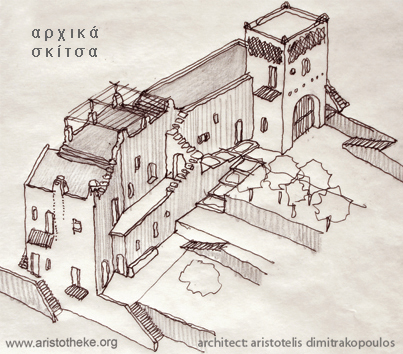
Tower Distortions: The tower mass embraces the outdoor stair that leading to the top terrace. Numerous versions have been generated reworking the form of the tower with cantilevered projections, truncations or skewed faces. A small balcony projects maximizing the vistas opened from the interior. This cantilever appears as inserted into a slot of equal length, into the mass of the tower. The morphological challenge of the large garage door was resolved initially with an arch reworking the stone masonry language, and later evolved into a void between two shearing slices of the tower surface.
Dove Suite- Master's Suite [Access]: The master suite in the upper level of the tower can be accessed directly from the main house through interior stairs. Alternatively this level is accessed independently from the visually isolated exterior staircase behind the tower, or through any stair that leads to the terrace. A primary attribute of the tower is the immediacy to the outdoor terrain of the roofscape.
Mechanical Mezzo: A strong potential of the tower topmost deck is the accommodation of service units, air-conditioning coolers, sun-collectors, potable water tanks etc, or satellite receivers and antennas. This practical location for the central service units, visually isolated by a higher parapet wall or potentially a horizontal grillage, ensures that all service systems operate optimally, not interfering with the everyday movement patterns and views; rejecting the potential of ad-hoc systems installation that may sabotage the formal value of the tectonic synthesis.
Carport: The lower level of the tower becomes an evolution of the equivalent space in a vernacular dovecote, a service/storage room. The vehicle can be parked halfway into the tower and perpendicularly to the main oblong mass. In that axis, its size does not conform to the requirements for a parking spot. This condition reflects the constant mobility of the occupants, not necessitating to park permanently but simply pulling into the shade. The long-term parking spot, provided that an automobile is left permanently in the island, is this exact space, accommodating the vehicle in the other dimension, parallel to the house, as described in the drawings.
Outdoor Living: The terracing outdoor spaces are defined by strong tectonic elements: stairs, retaining walls, vegetation, and built-in apparatuses of domestic life, such as a grill and furnace area, storage for the wood and coil and preparation surfaces. The pool becomes an off-center node, visible from all interior spaces, injecting energy to the south court. The retaining wall dips into the water, animated by small niches, reversing the cliché of a piscine with all-around access. This is a cliff pool, making experientially apparent the surrounding retaining walls. The pool is not dug into the soil, but is literally shelved into the steep slope.
Uphill Bedroom [Access]: The up-most interior deck is envisioned as the second bedroom, a space that may also work as a workspace or as a second living area, responding to the demographics of the dwellers. The immediate connection to the outdoor prescribes its role as a more grounded and protected entity. Long interior views towards the main living area prevail in the absence of interior partitions. The hygiene spaces located in the central area of the house serve the upper bedroom also. Responding to scenarios of programmatic mutability, no exclusive bathroom is assigned to this upper deck.
Lounge: The lower deck at the front edge of the main volume is the living area, separated only by a half-story level difference from the dining and entry zone. This is the widest space of the house, shaped as a broad arrowhead. A central fireplace, along with balcony doors and a number of directed openings generate strong connection with the exterior space. Elaborating on the natural topography, this space appears elevated even if it is on the ground level. Interior access is provided to a basement level and to outdoor spaces on either side. The space is envisaged as an open amphitheater oriented towards the sea, as the apex.
Materiality: Focusing on texture and prioritizing natural light, the material palette bestows the raw beauty of the landscape. Enduring details, stone masonry, secondary timber elements, raw exposed materials, subtle colored-concrete surfaces smoothly turning from vertical to horizontal and vise versa, provide uncommon yet simple solutions to ordinary tectonic questions. The focus of the material scheme is the constant shift of tonalities enabling the Aegean climate to conquer the house and embrace it within the experiential wonder of the Cyclades.
Related articles:
- HORROR VACUI: JOSTLE, HUDDLE AND HELLENIC MODERNITY ( 21 June, 2005 )
- ATTIC ECTOPIA ( 16 November, 2012 )
- FRONTAGE SHOWCASES AND THE POST-URBAN UNCANNY-A RECTROACTIVE MANIFESTO FOR HELLENIC PROFESSIONAL SPACES ( 01 January, 2010 )
- VI: Unrecycling Cyclades. Part 1 ( 04 October, 2010 )
- Gwangju Asian Cultural Center, Korea – International Competition Entry, October ( 7 December, 2007 )
- De-institutionalizing Education: Notes on Academic Initiatives(i) ( 7 July, 2007 )
- HARBORING CAR-BAN-ITIES [Port Nord Organizational Protocols] ( 8 October, 2007 )
- Stratifying Axialities> Celadina ReCelled (PART A) ( 14 March, 2008 )
- Stratifying Axialities> Celadina ReCelled (PART B) ( 11 April, 2008 )
- FRAGMENTARY IMPUNITIES > VALLADOLID TRAJECTORIES (PART A') ( 5 September, 2008 )
- FRAGMENTARY IMPUNITIES > VALLADOLID TRAJECTORIES (PART B') ( 5 November, 2008 )
- SUBTERRA * SUPRATERRA ( 22 May, 2009 )
- Translocality as a Post-Native Narrative ( 16 February, 2011 )
- Metaxekisis : Re-Thinking the Athenian Court ( 08 December, 2010 )
- L-I*-THEKE ( 02 April, 2013 )
- House - glyptotheque - gallery - workshop ( 19 July, 2013 )
- Piloting Pilotis ( 31 December, 2013 )
- Escalteca of the Choetheque Series ( 01 April, 2014 )
- Schottheke of the Choetheque Series ( 01 June, 2014 )
- Floatheca Rh of the Choetheque Series ( 01 August, 2014 )
- Floatheca Sp of the Choetheque Series ( 26 September, 2014 )
- O-theke of the Choetheque Series ( 11 March, 2015 )
- Floatheca Cy of the Choetheque Series ( 03 January, 2015 )
- Ophthalteca ( 24 June, 2015 )
- Y-theca of the Choetheque Series ( 08 October, 2015 )










